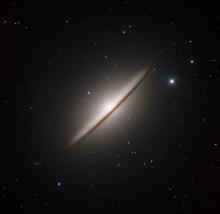Listen to today's episode of StarDate on the web the same day it airs in high-quality streaming audio without any extra ads or announcements. Choose a $8 one-month pass, or listen every day for a year for just $30.
You are here
Monoceros
With a name that means “the unicorn,” you might expect the constellation Monoceros to have an interesting story. Unfortunately, though, it doesn’t. It was created mainly to fill in a dark region of the sky near bright Orion the hunter, which is in the southeast in early evening.
The first confirmed record of the constellation is in a 17th-century sky atlas. The atlas was produced by a Dutch mapmaker and astronomer who created a score of constellations in all. Most of them are still in use today — including Monoceros.
The unicorn isn’t much to look at. From a light-polluted city, in fact, you might not see any of its stars at all.
Appropriately enough, though, one of the constellation’s most interesting residents is a black hole — the closest one to Earth yet seen. It’s roughly 3,000 light-years away. It’s nothing to worry about, though — it’s far enough that it’s no threat to Earth.
While there’s not much in the unicorn to see with the eye alone, a telescope reveals quite a few beautiful sights. The list includes star clusters and several nebulae — big clouds of gas and dust.
Hubble’s Variable Nebula, for example, consists of a young star that’s embedded in a cocoon of material. The star lights up that cloud, making it glow. It’s possible that the cocoon is hiding a young planetary system — new worlds that haven’t fully taken shape.
Monoceros also contains a couple of beautiful stellar nurseries, and we’ll talk about those tomorrow.
Script by Damond Benningfield






